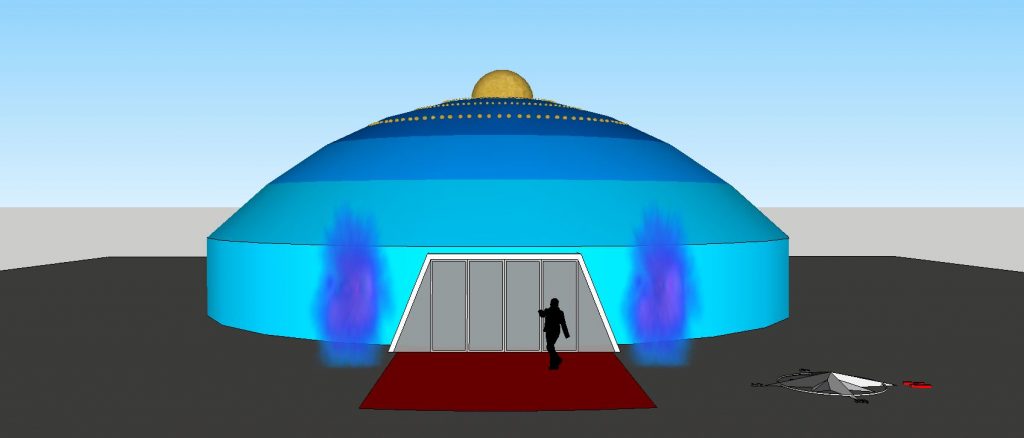
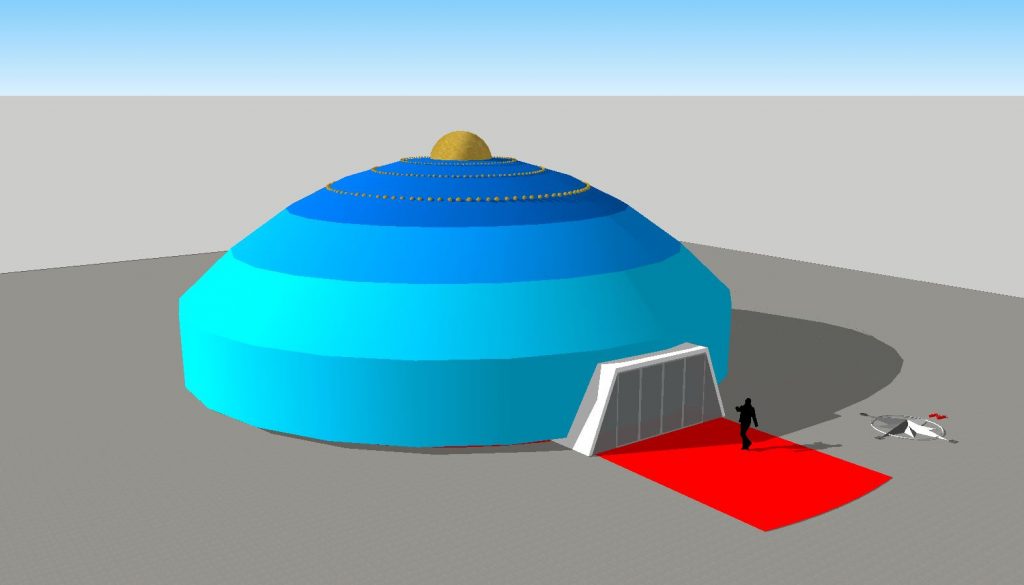
The venue for Cave 3.0, itself the ‘Cave’ wherein the whole opera unfolds, is a 21Ø x 9,5mh self-contained geodesic dome located at the periphery of selected urban areas[1] with the entrance facing East. Inside the Cave, dwells the Paradigmatic Matrix, the Cube. Hence, the Dome and the Cube, Heaven and Earth, the theatrical stage for a laic initiation of consciousness.
The access to the Cave is paved by a ‘red carpet’, at both sides of which are placed 3 posts brass-stanchion connected by red twisted ropes[2]. At the top of the poles, a golden Rose[3] and a Cypress[4] in alternated sequence, whose succession is reversed in the facing row. At each side of the entrance doors, 2 blue floating holograms, the Guardians of the Treshold[5].
In the internal space of the Cave, the Cavea, the stepped tiers of seats are arranged in seven[6] coloured concentric circles — the 7 levels of consciousness, or realms, the 7 heavens[7], the 7 chakras fields, the colours, the musical notes, the operatic voices, the Septet[8] playing the music of Cave 3.0, etc. — intersected at their centre by a 4 rayed corridor (parodoi) pattern heading to the 4 cardinal directions of space — the 4 elementals; air, water, fire, earth; the 4 seasons, and all the other symbolic numerical association of 4 — gangways used by the performers, and by the audience to enter and exit the Cave before and after the performance.
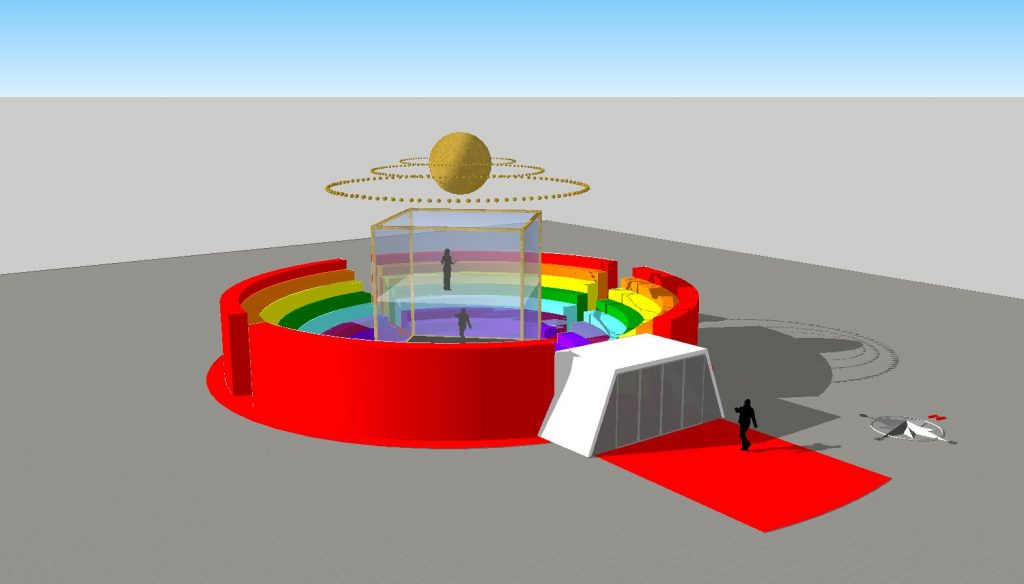

At the centre of the Cave, on the violet smallest circle from which the 4 rays expand and diverge, stands the Matrix, the quintessence, a three-layered golden cube of 6m of face — the Earth — upon and around which human and hologram perform the operatic narrative.

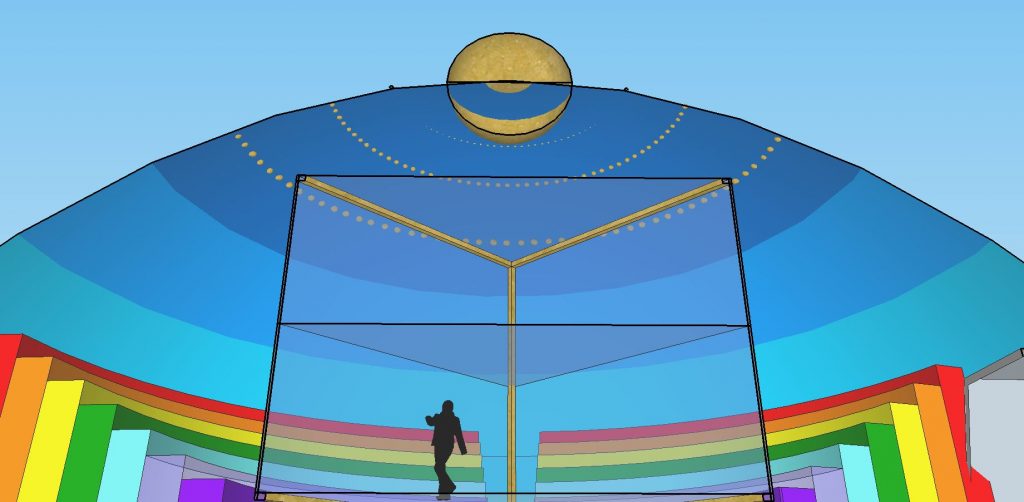
On the vault of the dome — the Heaven — starting at the level of the upper face of the Cube comprising the first 4 levels of consciousness, there are 3 concentric circles of intensifying blue gradation — the 5th, 6th and 7th levels of consciousness — ascending in space and decreasing in size from the lighter to the darker. At the top of the vault, as keystone[9], a golden globe emanates a red laser beam — the axis mundi — and three golden expanding circles of spherical holograms — the highest 3 of the 7 Heavens.
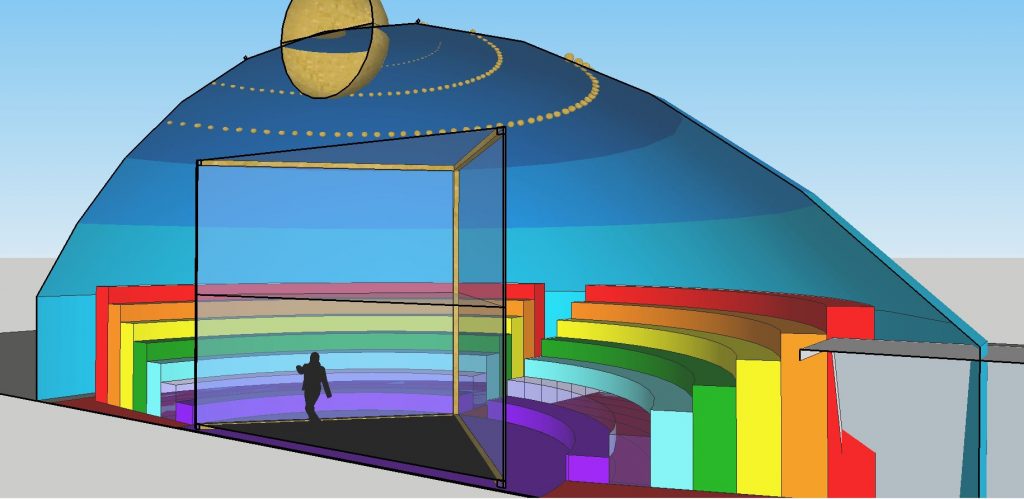
At specific points of the plot, on the three-layered blue vault are screened a series of diaphanous sequences relating the cosmic meta-narrative, the ‘timely’ involving and interrelating with each other’s action, and a reflecting of the human condition unfolding underneath on the Matrix, on Earth.
Thus, the Venue/Cave is a multidimensional theatrical space within and around which the operatic performance/rite takes place. Cave 3.0 will be performed in a 7-day cycle, each day welcoming 350 people/souls only, a way to share subtle food in a safe, friendly, healthy and highlighted sustainable environment. The cycle will be replicated in each of the selected tour-legs:
Simulation by Shay Baron.
[1] Changes always start off from the margin, while the ‘centre’ is the establishment well rooted in its status quo.
[2] The rope takes some of its symbolism from the thread or cord, and from the stairs, it is a means of ascent. Although ladders, ropes and wings all appear to be similar as means of ascent, symbolically there is a distinct difference. The ones with wings are those who are capable of having spiritual experiences with little difficulty, the mystics, naturally able to ‘fly’. Those with ladders and stairs have a slow upward climb involving stages and steps towards enlightenment. The ones using ropes need assistance from above, and occasionally from below, and have to pull themselves up by hard work and perseverance against the ‘gravity’ of the pull to the Earth – the physical.
The rope denotes that which conjoins, in this acceptation it stands for the Axis mundi, the immaterial pole uniting Heaven to Earth (see “The Cube” page, n5). According to a Toba Battak myth, in the primordial beginning, a rope linked the Earth to the Sky to enable the formation of the Earth and the development of human life and culture. In Mayan mythology, a rope links Sky and Earth as an umbilical cord to regulates the life of the first beings and to provide them with food. Yet the rope was cut — the severing of the axis of the world — Earth and Sky were parted, signifying the ‘rapture’ of the individual from the cosmic consciousness occurrence in mythical times, which endangered the flow of energy at both ends.
In magical and symbolical thinking three aspects of ropes are stressed most: i) they provide the means to ascend, enabling humans to reach the highest states of consciousness. In mythic times the ascent had been possible for all beings, now only those with high spiritual power succeed; ii) ropes link things with each other, and all of them with the cosmic consciousness to enable the exchange of energy among all domains. Humans who have knowledge of these ropes are the initiated ones of their culture; iii) ropes have the function of binding and loosening. The very conflicting nature of this function is reflected in many myths and magical rites. The act of binding can mean punishment, enslavement, illness, or death for the bounded one, but it can also tie the individual to the cosmic consciousness, thus integrating the individual in the cosmic order. Analogously, the act of loosening can mean physical and spiritual liberty, health, and life to the loosened one, but also a loss of the highest state and the unleashing of chaos. As the act of binding and loosening has such important meaning for the material-spiritual wellbeing of all sentient beings, and for the regulation of the cosmic order, the power of binding and loosening is a quality only of the highest gods (e.g. the Indian god Varuna) or god-like heroes and kings; it is the power of the silver and the golden keys of the pontifex, the bridge builder, or the solve et coagula of the alchemical process. In the Old Testament, God illustrates the deep gap between his own power and that of Job by asking him (Job 38, 31): “Do you bind the ties of the Pleiades, or do you loosen the ties of Orion?” Another example from the Gospels shows the power of binding and loosening as a means for establishing moral order: when Christ appointed Peter as the head of the church, he told him: “Whatever you shall bind on Earth shall be bound in Heaven” (Matt. 16: 19), indicating how the micro and macrocosm are tied by the axis mundi. In the North American sun-snaring myths, a basic motivation was to punish the sun for its bad behaviour, which means that binding and loosening something, whether among human beings or celestial bodies, means also to establishing moral or spiritual order.
In magical thinking, ropes establish the cosmic, the ethical, and the social order. By their use, gods, shamans, heroes, or kings can manipulate the cosmic order in its different aspects. The process of binding and loosening of ropes means a transformation of conflict into law and order, of chaos into cosmos.
[3] Rose fossils 35 million-year-old have been found in Europe, and petrified rose wreaths have been unearthed from the oldest Egyptian tombs. Within the context of earthy current lore, a rose symbolises immortal love, union through time and death. Its mundane beauty is a promise of Truth and Goodness, a new beginning, of hope; yet, its beauty is contrasted with thorns — pain, defences, physicality, loss, thoughtlessness, and lack of awareness.
The flower bears a complex paradoxical symbology in that it is at once a symbol of purity & passion, of heavenly perfection & earthly desire, virginity & fertility, death & life; and it is the flower of the Goddesses, of Kama, Isis and Venus, nonetheless the blood of Osiris, Adonis, and Christ.
Originally a symbol of joy, later on, it stood for secrecy and silence. Numerically, the rose represents the number 5 — the wild rose has five petals, and the total petals on roses are in multiples of 5. Geometrically, it corresponds with the pentagon, while in musicology the pentagram is where all notes are fixed and played. Fife represents the Fifth Element, the life force, prana, ether; and the heart, or the kernel, the essence of something. In spirituality, it is the expanding awareness throughout the 5th plane of consciousness.
Six-petaled varieties — the 6th chakra, partaking of and denoting the same numerical paradigm — indicate balance and love; the seven-petaled stands for transformative passion; and the rare eight-petaled roses designate full regeneration, a new cycle, or a transmuted state of consciousness.
The popular symbolism of the colour of the petals of the rose runs as follow: white: purity, innocence; acceptance, unconditional love; feminine, passive energy; red: passion, love; vitality, aliveness, creativity; masculine, active energy; pink: gentleness, softness, thankfulness, loving and supportive energy; orange: enthusiasm, fascination, optimism; yellow: compassion, free-flowing joy and security; blue: spiritual longing, rituality; black: depression, death; golden (or gilded): completion, perfection of oneself; invocation of cosmic energy.
The rose is one of the fundamental symbols of alchemy. Rosicrucian texts are called Rosarium (Rosary), all dealing with the relationship between the two archetypal polarities, the positive and the negative, yang and yin, the King and Queen. Here, the rose is the symbol of the mystical marriage of opposites, the Conjunction, or the regeneration of separated essences-polarities and their unified transmutation into a new level. in Jung words: “The wholeness which is a combination of ‘I and you’ is part of a transcendent unity whose nature can only be grasped in symbols like the rose or the coniunctio” to be experienced by the enlightened soul.
The red rose is masculine, active, expansive, solar spirit (Sulfur), yang; the white rose is feminine, receptive, contractive, lunar (Salt), yin. The combination of white and red roses (spirit and mater, the Sun and the Moon) symbolizes the birth of the Philosopher’s Child (Mercury, mercurial; Hermes, hermetic). During the Conjunction, the relationship of the red rose to the white rose is that of the Red King and the White Queen, or the Red Sun and White Moon. White roses are linked to the White phase of the work (albedo) and to the White stone of Multiplication; the red rose is associated with the Red phase (rubedo) and to the Red stone of Projection. The golden rose is the result of a successful marriage of opposites, which produces the Golden Child — Homo universalis, Adam Quadmon, Insan-al-kamil, etc.), the perfected essence of both King and Queen. In alchemical drawings, the rose garden is a sacred space; it could mean an intimate meditation space, or a tabernacle, an altar, a sacred place in nature, or the paradise. Any which way, the rose garden is the mystical bridal chamber, the realm of the mystic marriage.
The rose is connected with sexual energy, the ‘warm red’ alchemical tincture purifies, distils or sublimates sexual energy. The rose red colour relates to the aqua permanens and to the soul, extracted from the prima materia. The single red rose represents the mystic centre of a person, one’s true nature, his or her heart of hearts; and the purification process of the essence, the inner “pearl beyond price.” Rumi says: “In the driest whitest stretch of pain’s infinite desert, I lost my sanity and found this rose.” As a symbol of the conjunctio at a personal level, it is the love that transmutes the individual self into the cosmic Self, where the old identity is surrendered for that of the Beloved, or for a higher awareness of the identity of consciousness. In this acceptation, the rose is a symbol of complete surrender and the permanent transmutation into a new state of consciousness.
Because of its association with the heart, the rose symbolizes the secrets of the heart, all things that cannot be spoken, or an oath of silence. In its folded structure the flower seems to be concealing a secret inner core: “Mystery glows in the rose bed, and the secret is hidden in the rose,” says the twelfth-century Persian mystic Attar.
In Christianity, Mary is the model of union with God, Marian Middle Ages iconography depicts her in rose gardens, under a rose arbour, before a tapestry of roses. She holds a rose and not a sceptre, for her power comes from divine love; the rose and the rosary are her cyphers, symbols of the union between God and mankind.
In many Indo-European languages, the word Rose is an anagram for Eros. To perceive the archetypal signature of the rose it is necessary to be open to its presence.
[4] From anc. Gr. κυπάρισσος (kupárissos), prob. from an unknown Mediterranean pre-Greek language, and probably from ancient Hebrew גפר (gopher), cypress, the name of the wood tree used to make the ark (Genesis. vi:14), in gematria letter tuning פגר, carcass, remain, corpse, cadaver.
The momentous density of the foliage and its solitary aspect draw the cypress along a pathway beyond the biological realm. A vegetal hermaphrodite carrying both the male and female principle in the same tree, for inversed symbolical analogy it became associated with the a-gender soul, and to its departing from the human realm with the affliction of separation, and with a longing to unravel the mystery of reunification in the final rite of passage.
“Let me be laid in a casket of cypress wood embraced by death while the breath flies away” (Twelfth Night, 11:4) echoes Shakespeare’s soul, while the Egyptians and Greeks funerary rituals are burying their dead in cypress coffins, for its resistance to decay reinforces the vision of immortality.
Cyparrissus son of Telephus, a handsome young lad of Cos, every day grazed his dearly sacred stag. Apollo followed after him as he accidentally slew the animal with a javelin as it lay resting beneath a tree. Grieved for his insightful act, he wished to die and, despite Apollo’s protests, wept until his body dried up and transmuted into a cypress tree.
In the Mazdean tradition, Zoroaster brought a shoot of the tree down from heaven to earth where he planted it. In Middle Age Persian miniatures iconography, the tree stands by the mystic seeking enlightenment; old Japanese lore recounts for tribal people living among a giant species of cypresses named God Tree, the same variety planted in China and on the Himalayas near temples and monasteries, where they live to be as old as two thousand years. Among Buddhists, Shinto and Taoists it is sacred, cultivated near pagodas and temples. The Greeks and Romans held that Cupid’s darts, Jove’s sceptre, the club of Hercules and Boaz and Jachin, the pillars of Solomon’s temple, were all made from cypress wood. Some of the precious statues of Avalokiteshwara, the Buddha and various Bodhisattvas brought by the Tibetans fleeing their homeland were carved from strong cypress timber.
As the Rig Veda “Hymn to Death” recites: “The Mahayogin Lord Shiva dances amongst the flames of the graveyard, mirrored in the disciple who balances perfectly in consciousness the dual force of life and death, for his eye is fixed upon the realm beyond heaven and earth. His journey along the paths of this world crosses the boundary of the cypress gate times without number, and he pauses not beneath the bright gaze of Yama [the god of Death], for he has shaped his own will to reflect the Dharmaraja [ the cosmic law]. He moves in and out of the realms of Heaven and Earth with the ease of the thread-soul passing through the eye of a needle. He knits together in his many vestures the worlds above and below until he stands like a tall and stately witness upon the mountainside, buffeted by wind and feared by men, he is a Master of Life and of Death”.
[5] The two holograms at the entrance of the Venue stand for the Guardians/Dwellers of/on the Threshold, or the two polarities — the pillars of the Temple, the right and left sides of the Kabbalistic Tree of Life, the Sephirot of compassion and justice, balanced and synthesized in the neutral rod (the axis mundi) which emanates from Kether, the Crown, analogous to the sushumna nadi along the kundalini in Hinduism; or the debt and credit book, the Black and White Lodges, and so forth, all polarities that once integrated allow crossing the threshold in accessing the new dimension. In other contexts, the Guardians may be perceived as a single entity in a dualistic function, the not integrated Ego preventing the Self to grow up, as Cerberus at the entrance of Hades, or the Dragon to be killed by the spiritual power of Michael the archangel, or the temping Snake, the Hobgoblin watching the treasure, or Herod before whose wrath the Self-flees to a foreign land, not permitted to return home until the kingdom is cleared of Ambition, Pride, Vanity, Self-righteousness, etc. According to traditional knowledge, The Dweller on the Threshold must be confronted at an early initiatory stage of the evolution of consciousness.
[6] The cross-cultural focus on the number seven corresponds to the seven classical planets — the only objects in the sky visible to ancient astronomers — that move in predictable fractal patterns against the daily rotation of the fixed stars. Among commentators there are usually two interpretations of the number 7: in one, it simply means “many”, as in Arabic; or it is used literally as a numeral.
[7] In mythological cosmology, the seven heavens refer to the seven subtle divisions of Heaven, the abode of spiritual beings, or the gross expanse containing the Sun, Moon and the stars. This concept dates back to ancient Mesopotamia and can be found in the Abrahamic traditions, a similar concept is also to be found in Hinduism. Some traditions, including Jainism, also have the concept of seven Earths or seven underworlds. It was probably a symbolic concept, as in the Sumerian language where the words for Heaven (or sky) and Earth are respectively Anand and Ki. Sumerian incantations of the late second millennium B.C. make references to seven heavens and seven earths, as in an-imin-bi ki-imin-bi, “the heavens are seven, the earths are seven.” In general, heaven is not a place for humans, in the Epic of Gilgamesh, the hero says to his friend Enkidu — a projection of the Self — “Who can go up to heaven, my friend? Only the gods dwell with Shamash forever.”
Along with the idea of seven heavens, the idea of three heavens was also common in ancient Mesopotamia. In Judaism, Christianity and Islam, the Third Heaven is a division of Heaven in spiritual cosmology. In some traditions, it is considered the abode of the Almighty, in others, a lower level of Paradise, commonly the lowest of the seven.
The notion of seven heavens may have been derived from the “magical” properties of the number seven, like the 7 demons or the 7 thrones. The number seven appears frequently in Babylonian magical rituals. The seven Jewish and Islamic heavens may have originated here. In Islamic sources, the concept is presented in metaphorical terms. The Qur’an frequently mentions the existence of seven samaawat (سماوات) (pl. samaa’a (سماء)), customarily translated as ‘heaven’. The term is cognate to the Hebrew shamayim (שמים). Each of the seven heavens is depicted as being composed of a different material, and the prophets are resident in each. The first heaven Rafi’ (رفیع) is made of silver and is the home of Adam and Eve, as well as the angels of each star. The second, Qaydum (قیدوم), is made of gold and is the home of John the Baptist and Jesus. The third, Marum (ماروم), is made of pearls or other dazzling stones; Joseph and Azrael are resident there. The fourth, Arfalun (أرفلون), is made of white gold; Enoch and the Angel of Tears reside there. The fifth, Hay’oun (هيعون), is made of silver; Aaron and the Avenging Angel hold court over this heaven. The sixth, Arous, (عروس), is composed of garnets and rubies; Moses can be found here. The seventh heaven, Ajma’ (عجماء), which borrows some concepts from its Jewish counterpart, is composed of divine light incomprehensible to the mortal man. Abraham is a resident of the seventh heaven. According to some traditional sayings of Muhammad (hadiths), the highest level of Jannah is firdaws, — from which the term ‘paradise’ derives — while a Lote tree (Sidrat al-Muntaha) marks the end of the seventh heaven. One interpretation maintains that stars and galaxies are all part of the “first heaven”, beyond which, six still higher/deeper realms are to be found.
[8] See the organic of Cave 3.0 music Septet at “The Score” page.


